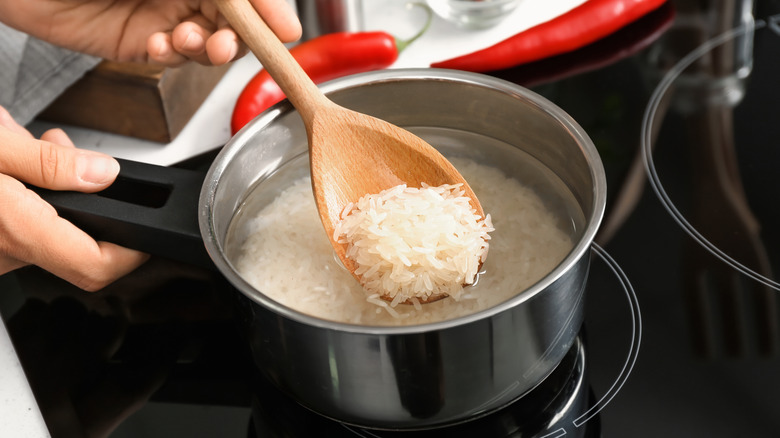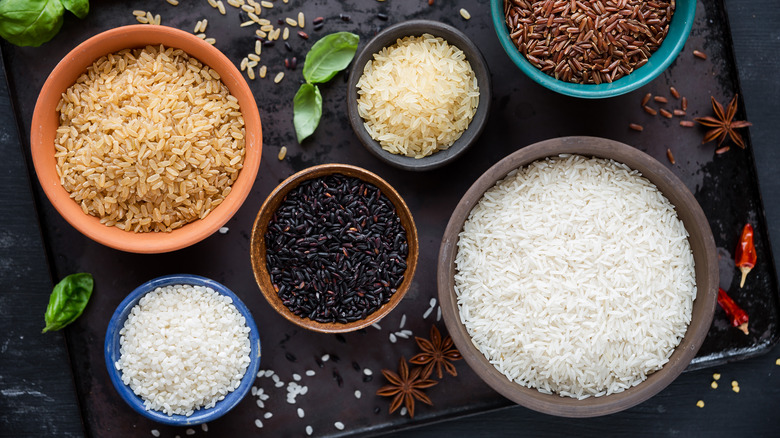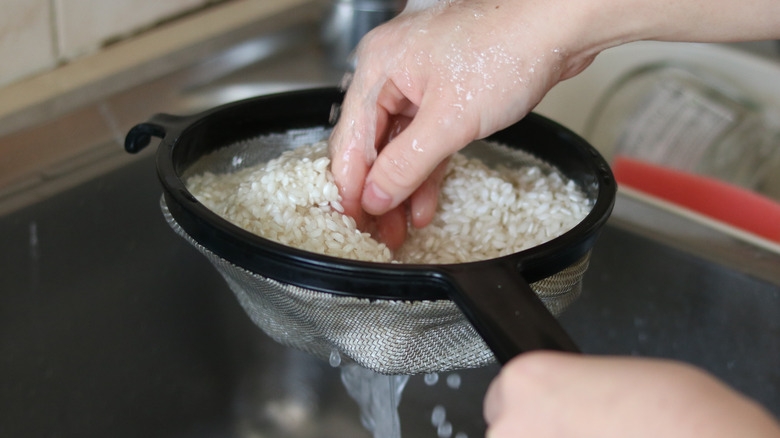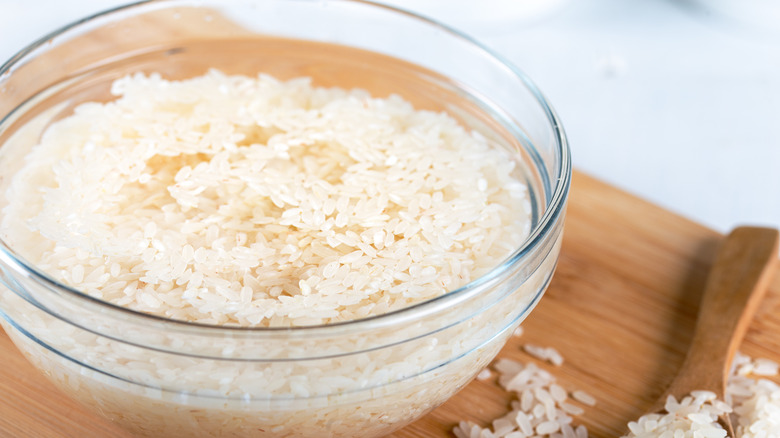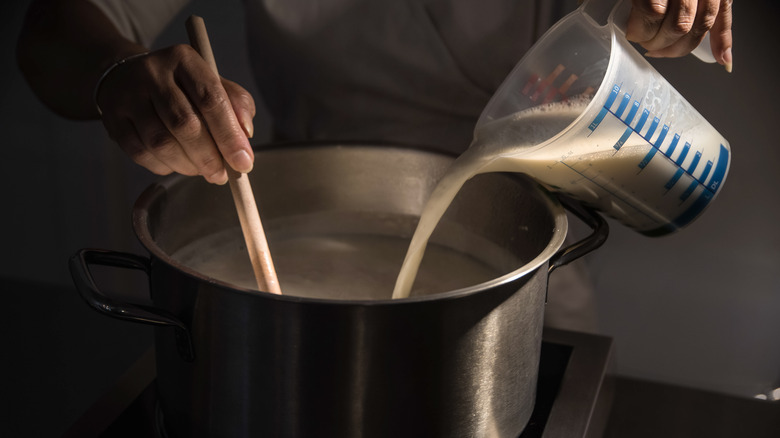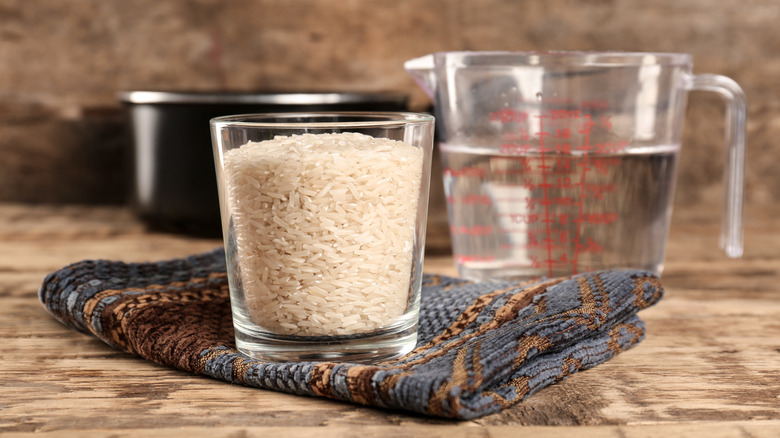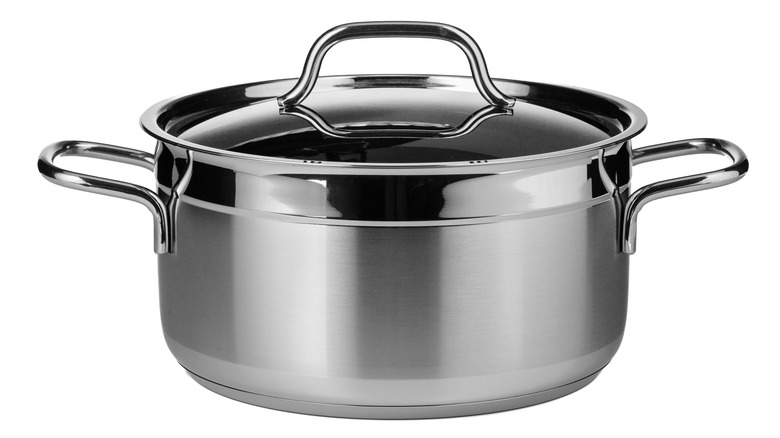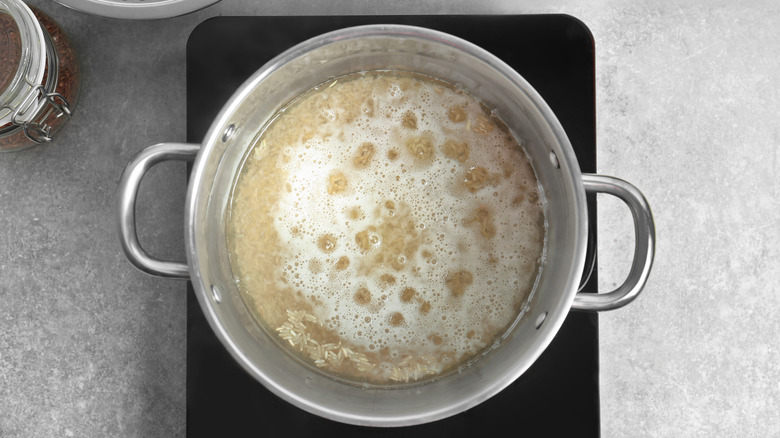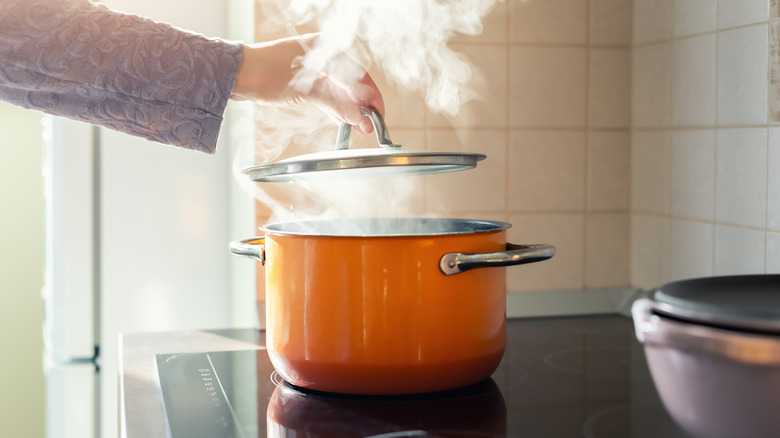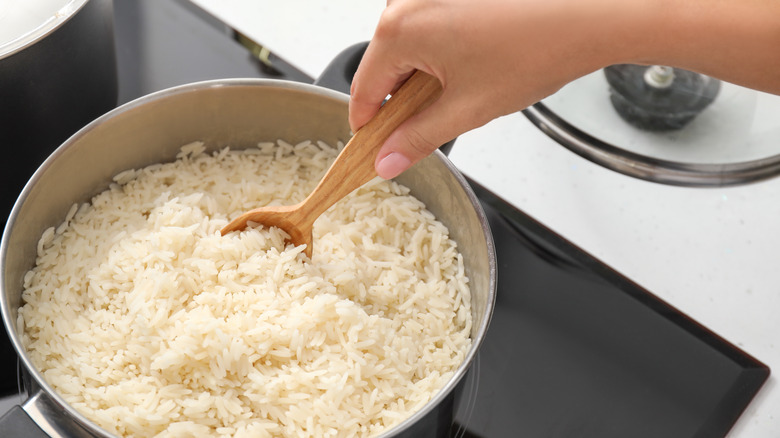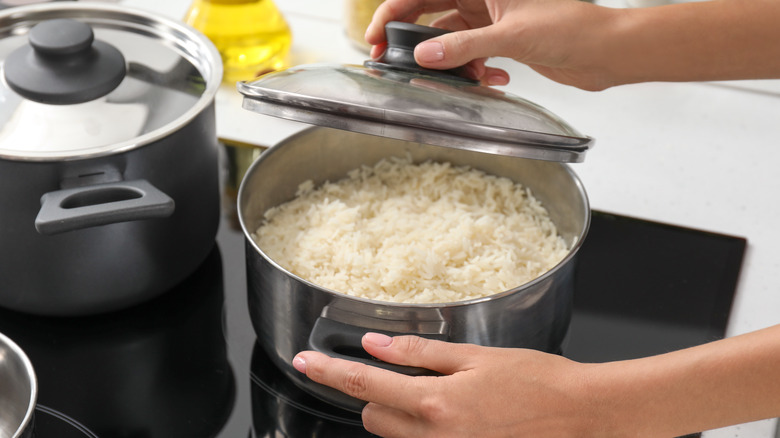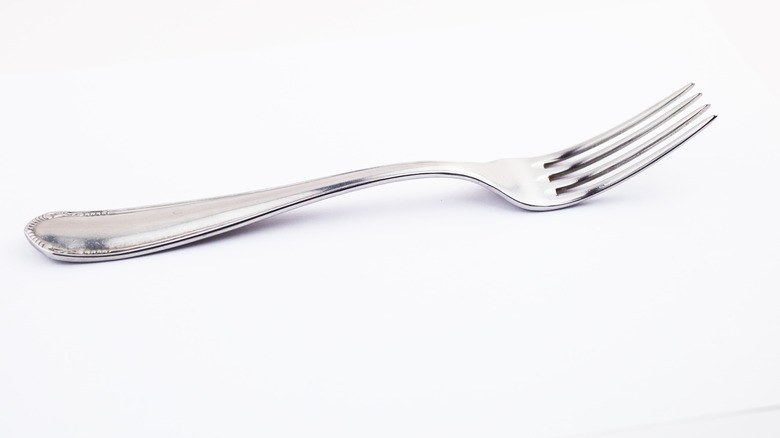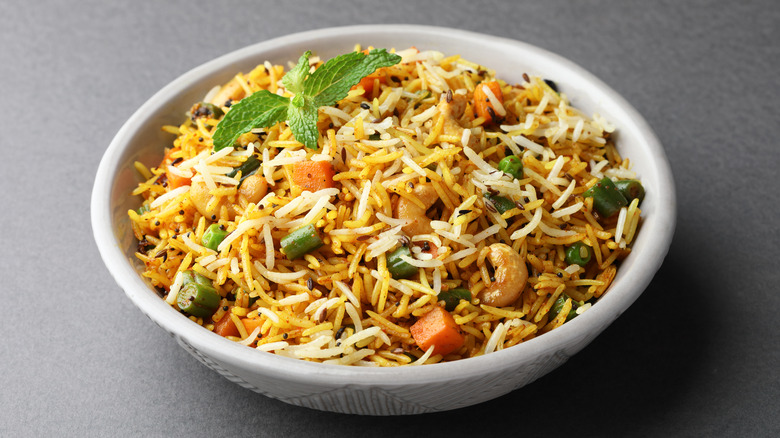Here's The Right Way To Cook Rice On The Stove
Rice is the world's preferred staple crop, with more than half of humanity relying on the crop for a significant part of their diet. With the grain showing up in traditional foods in pretty much every corner of the globe, there are innumerable ways to turn it into something delicious. In areas where people eat almost every meal with rice, rice cookers are the preferred tool. The Instant Pot can also make excellent rice, and you can even make serviceable rice in the microwave if you don't have any other options.
You can also cook perfect rice on the stove in a regular pot, but this route is not for the faint of heart. The simple directions on the back of the bag might make you think that the stovetop method is easy, but it requires precise control of many variables, including heat, moisture, and evaporation. Don't let that scare you off: Once you get your procedure down, you can easily make your rice taste just as good as it would from any restaurant or fancy gadget.
For this tutorial, we will be focusing on the absorption method, where you try to precisely measure enough rice and water to give you perfectly cooked grains with no excess liquid. This is the most popular way to cook it, and it's the best way to achieve the fluffy, aromatic white rice that machines are so good at making.
Choose the right kind of rice for the dish you're cooking
Although different species of rice were domesticated independently in China, Africa, and North America, the Chinese variety ended up dominating the global rice industry. Today, all the commercially-produced rice in the world is the Asian species Oryza sativa. Every permutation of the grain, from long, slender, fragrant basmati to short, creamy arborio, is a subspecies of this versatile plant.
Rice can be loosely sorted into two main categories: short/medium grain and long grain. Short and medium grain rice varieties are mostly the japonica subspecies and tend to produce a finished product that is either sticky or creamy. That's because they have a lot of a type of starch called amylopectin that leaks out during cooking and creates a gummy coating on the exterior of the grains. Some examples of dishes that traditionally use short grain rice are sushi, risotto, paella, and sticky rice cakes. Long grain rice is usually from an indica subspecies and tends to cook into fluffy, separate grains. Basmati, jasmine, and generic American white rice are all indicas. They're usually more fragrant than japonicas and are used extensively in Indian, Chinese, African, and Cajun food.
When rice is harvested, the grain is surrounded by a tough hull. Brown rice is partially hulled, while white rice is polished until the grain is totally exposed. The cooking methods in this article will work for both brown and white rice, but brown will take more time to finish.
Rinse your rice
You don't technically need to rinse rice to cook it, but rinsing will significantly improve the texture and flavor of the finished product. Raw rice is covered in a fine layer of powdered starch that will turn into a gelatinous goo when exposed to heat and moisture. This extra starch will prevent you from achieving perfectly fluffy and separated long grain rice. Even for short grain dishes where you want the rice to stick together, excess surface starch can turn it into a pasty mess. Rinsing also removes any other dust and debris that may or may not be clinging to your rice, making it taste cleaner and fresher.
To rinse rice, simply pour water over it, swish it around, drain, and repeat until the rinse water comes out relatively clear. The exact number of rinses depends on how starchy your rice is and your level of patience. You can use a strainer to drain, but if you're feeling lazy you can simply pour the water out of your rinsing vessel — the rice won't go down the sink with the water, we promise. If you really don't want to make any extra dishes dirty, you can even rinse the rice directly in the pot you'll use to cook it.
Many types of rice require soaking
Like rinsing, you can skip soaking if you're pressed for time and don't want to go to the extra trouble, but it's worth the minor hassle. Soaking allows rice grains to partially hydrate before they're cooked, resulting in more even doneness. For certain types of rice, the process is a must. Sticky rice is always soaked before cooking, and soaking is a traditional part of Japanese rice technique as well. Soaking brown rice can help it cook more quickly.
The Huffington Post notes that cooks in Indian kitchens swear by soaked rice, because it helps preserve basmati rice's aromatic qualities and reduces its grainy flavor. Soaking also rinses off an antinutrient compound called phytic acid that reduces your body's ability to absorb zinc and iron. If you struggle to maintain adequate zinc and iron levels in your body, soaking your rice can help you get more of these nutrients in your diet.
Start with cold water
Different starch foods respond differently to boiling water. If you're cooking pasta, the conventional wisdom is that you need the water to be at a rolling boil before adding the noodles to help them cook evenly and prevent sticking (although some modern cooks disagree with this advice). Conversely, throwing potatoes into water that's already boiling will leave you with mushy exteriors and raw insides (via Food52).
Like potatoes, rice will cook more evenly if you start it in cold water and then bring it to a boil. Beginning with cold water lets the rice hydrate gradually, resulting in a more even cook. Adding rice to boiling water risks breaking down the outside of each grain while leaving the interior crunchy. This is especially true for white rice that lacks a protective husk. Note that this advice applies only to the standard absorption method that we've been discussing in this article. If you're cooking rice via stovetop boiling where you use a big pot of water and drain the excess moisture with a strainer (as you would cook pasta), you want the water to be at a full boil before adding the rice.
Rice to water ratio is important
The ratio of water to rice in the pot is one of the most contentious issues in all of rice cookery. A quick web search reveals recipes that use 2 to 1, 1.5 to 1, 1.25 to 1, and even 1 to 1 ratios. What's the reason for all the disagreement? Evaporation. According to Serious Eats, all varieties of rice absorb an amount of water equal in volume to the amount of grain, so a 1 to 1 ratio. However, most kitchen pots don't have an airtight lid, so some water evaporates during the cooking process.
The exact amount of evaporation depends on how loose your pot lid is, so that explains why different cooks recommend different ratios. If you want to totally eliminate the evaporation variable, you can follow the method recommended by Serious Eats, which uses plastic wrap, aluminum foil, and heavy weights to create a totally airtight seal. With this technique, you don't need any extra water to make up for lost steam. The airtight method is a little complex for a casual weekday pot of rice, though, so your best bet for figuring out your perfect ratio is to use the same pot every time and experiment with dryer and wetter mixtures until you've achieved perfection.
Choose your pot wisely
We touched on this before when we were discussing ratios, but when you're choosing a rice pot you want something with a tight-fitting lid. You're trying to trap as much steam as possible because the steam is what cooks the rice all the way through. A loose lid may let too much moisture escape, leaving you with crunchy, underdone grains. If your rice pot has a leaky lid, you can cover the pot with aluminum foil or weigh the lid down with something heavy to get a better seal (via Serious Eats).
The lid isn't the only pot factor that will affect your rice success. You also want to choose something that's appropriately sized for the amount of rice you want to cook. For most people, a two-quart pot is the sweet spot. That will let you cook one to two cups of rice without risking a boilover or leaving so much space in the pot that the steam can't build up enough to soften the rice (via Simply Recipes).
Start hot, then lower to a simmer
Once you have placed your rinsed rice and the proper amount of water together in the correct pot, you can finally start cooking. Bring the water and rice to a boil, uncovered, on medium-high heat (via What's Cooking America). Leaving the lid off while your water heats up helps guard against the pot boiling over. After your pot reaches a boil, lower the heat to a simmer, put on the lid, and cook until the rice is done, around 12-15 minutes depending on the type of rice (brown rice will take longer).
Simmering and boiling are terms that people throw around in recipes without bothering to define them, so it's worth explaining what they actually mean. Fine Cooking notes that simmering liquid produces consistent, small bubbles with a little bit of steam. When liquid boils, you should see larger, more vigorous bubbles and a greater volume of vapor. Now you know how to boil water, and no one can ever take that away from you.
Don't take the lid off
Cooking rice with proper technique is an exercise in patience and trust. Once the water has come up to a boil and you put the lid on the pot, you really shouldn't take the lid off until the rice has finished cooking. As you can probably guess, lifting the lid to take a peek lets out a bunch of steam and can make your rice cook unevenly. It might be tough to resist taking a look at your rice while it's cooking, but you need to be able to trust that your time and temperature settings are doing what they're supposed to. Since everybody's stove is different, you'll probably have to employ some trial and error to dial in your heat level and the precise timing, but once you've figured it out there's no good reason to take the lid off during cooking. Choosing a pot with a see-through glass lid can take some of the guesswork out of the process as well.
Dickson Data tested what happens when you remove the lid while cooking rice, and they found that even a small amount of time with the lid off negatively impacted their rice. They removed the lid three times for 10 seconds each, for a total of 30 seconds with the top off. Compared to a control batch that had been covered the whole time, the lid-off rice was uneven, with a dry top and a wet bottom.
Don't stir while the rice is cooking
This is another area where you have to learn to not be an anxious cook. We are hardwired to want to poke, prod, and investigate food while it's on the stove so we can check how it's progressing. Some ingredients just need to be left alone, however, and one of them is rice. According to Carolina, who should know what they're talking about since they've been selling rice for almost a century, stirring during the cooking process has the potential to damage the grains. These broken grains will further degrade as they finish cooking, creating a gluey, mushy texture. Usually, rice is best when every grain is kept intact so it's fluffy and light.
It's important to note that this advice doesn't hold for rice dishes where creaminess is the desired end result, like risotto. Stirring is a vital risotto technique because the agitation helps the rice release starch, generating the creamy sauce that makes risotto so craveable. You'll find many recipes online telling you that you don't need to stir to make perfect risotto, but in general, it's best to trust the wisdom of generations of Italian grandmas.
Let it rest covered after cooking
While you can technically serve rice right after you take it off the heat, it will never taste as good fresh off the burner as it will after a few minutes of covered resting. The reason for this is basically the same as why you need to rest large cuts of meat after cooking them: redistribution of moisture (via Martha Stewart).
When you cook a cut of meat, the juices inside become unevenly distributed. Likewise, when you cook rice, the top will naturally be drier than the bottom. Also, because the top of the rice is farther from the heat source than the bottom, it will likely be less cooked. Letting your rice hang out with the lid on for around 10 minutes will allow both the steam and the temperature to redistribute, giving you rice that's evenly cooked and moist from top to bottom.
Fluff with a fork, not a spoon
Most recipes tell you to fluff rice after it's cooked, but what does that mean, exactly? Fluffing refers to using a utensil to separate and break up the individual grains of rice (via CookThink). When rice cooks, it tends to stick together because of all the starch in the cooking liquid. Fluffing helps free up the rice so it's not just one big gloopy mass. It also adds air and lowers the temperature in the pot, letting any excess steam escape. This prevents your rice from overcooking and turning soggy.
But what to fluff with? Although you might be tempted to use the big spoon you'll use for serving, that large, clunky tool could damage the grains, making them pasty instead of fluffy. A fork will do a much better job because its delicate tines will gently lift and separate the rice instead of bashing it to pieces.
Experiment with seasoning and toasting to add flavor
Plain white rice is a wonderful accompaniment to dishes from all around the world, from curry to gumbo to teriyaki. Sometimes, though, you want rice to be more than just a starchy vehicle for a flavorful sauce. Options for flavoring rice range from subtle adjustments that enhance the taste of plain grains to elaborate preparations that turn rice into the centerpiece of a meal. Livestrong suggests toasting rice in a little oil or butter before cooking. You can add herbs, spices, and other seasonings during the cooking process to liven things up, or experiment with replacing water with more flavorful liquids like broth or coconut milk.
You can see how to apply these techniques in the real world by looking at specific recipes. Our own take on paella uses a flavorful base of onions and paprika cooked in oil that you toast the rice in before cooking with chicken stock, peas, and shrimp. Our lamb pilau features rice cooked in a fragrant broth made by cooking lamb with spices. Toasting rice in oil is also a necessary step in the process of making risotto.
